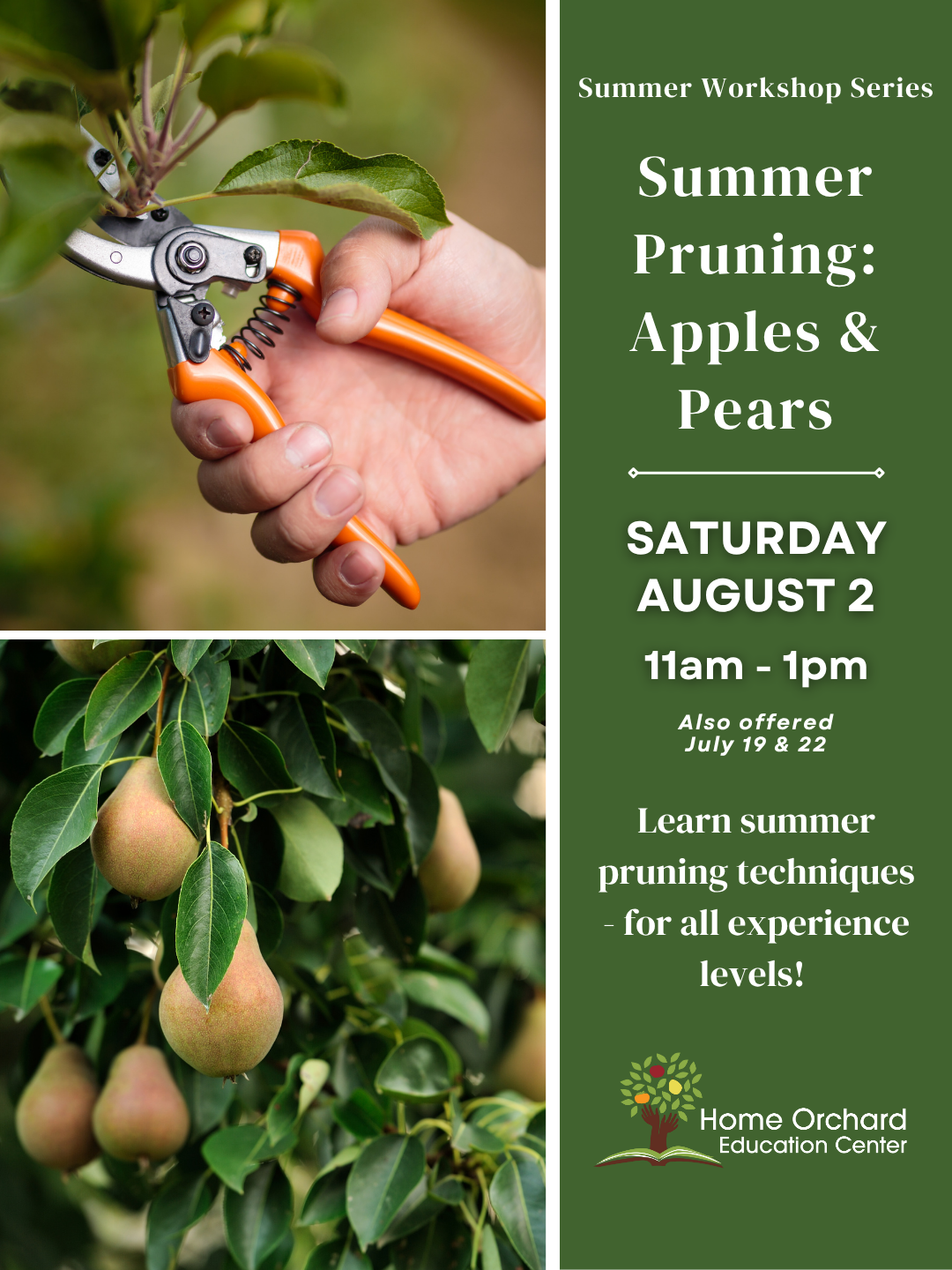Managing Your Bounty: Figs
Did you know that many varieties of figs produce TWO separate crops each year?
Here in the PNW where our warm season is often too short for that second crop to ripen, we are mindful to plant varieties known to produce a reliable and heavy early season crop to ensure we have a bountiful harvest. In warmer drier parts of the world, this first crop (called the “Breba” crop) is simply considered to be a "bonus" and their main harvest comes later in the year. In our climate, the Breba crop is usually what we have to work with, so make sure you are ready with recipes and preservation tips early in the year!
RIPENESS
All figs should be allowed to ripen completely on the tree when possible for best flavor and texture. Although they may soften a bit on your counter, figs generally do not continue to ripen properly after harvested. Picked too early, the juices and sugars produced as a fig ripens are not yet fully developed. Since it is better to err on the side of picking a fig that is slightly overripe rather than under ripe, don’t be surprised if the figs you take home or the best tasting ones appear a bit “smooshy” or if they are dripping from the eye of the fruit ~ that just means they have ripened to perfection!
PRESERVATION
Fig can be eaten fresh, frozen, dried, pickled, canned, or cooked into a variety of delicious recipes. Although figs will keep fresh for a few days in the refrigerator, they are not a long storing item unless first processed or preserved. You may consider using the softest, ripest fruits for fresh eating or drying, and figs that are slightly more firm for cooking or canning. Below we share a few easy methods to get you started!
Freezing:
Fresh frozen figs do retain their natural color, flavor, and texture if prepared properly. You may either wash and peel the fruit if desired or clean, dry, and leave it intact.
OSU Extension Service shares a variety of different methods for preservation of figs by freezing which include:
Sugar Pack - Roll the whole or half figs in sugar and then pack into freezer bags or containers.
Syrup Pack - Pack figs into freezer bags or containers and cover with a sugar syrup before freezing.
Dry Pack - Place figs in freezer bags as tightly as possible without mashing and seal.
Individual Quick Freezing- Freeze individual figs in a single layer on cookie sheets before packing in containers. This prevents them from sticking together. This can be used for either sugarpack or the dry packed figs.
Regardless of the method chosen for freezing, the containers should be sealed, labeled and frozen as quickly as possible.
Drying
Because fully ripe figs are naturally sweet, they lend themselves well to drying. You may dry figs in the oven, in a food dehydrator, or even outdoors in the sun on a rack or screen protected from critters. Drying might be a good option if you find yourself with deliciously smooshy fruit too soft for pickling or canning .
Wash and peel the fruit OR wash, dry, and leave the skin intact. (your author doesn’t bother with peeling!)
Large figs may be halved, quartered, or cut into slices to shorten the drying time and ensure consistent drying all the way through.
For most efficient drying, place the skin-side down.
The length of drying time can vary greatly depending on the size of your fruit, it’s moisture content, and your drying method. A good dehydrator with smaller fruit may take as little as 8 hours, while an oven closer to a full day, or a rack outdoors in warm weather multiple days. Whichever method you choose, be sure to keep an eye on your fruit, monitoring and turning if needed.
Your figs are ready for storage when they feel leathery with no visible areas of moisture remaining, but are still flexible and chewy.
Once dried let the figs cool down completely and then store in sanitized airtight containers in the fridge or freezer until you are ready to eat them.
Pickling
Before refrigerators and freezers were a common household item, most food was either eaten fresh from the garden or dried, fermented, or pickled in some way for later use and long term storage. Nowadays the term “pickled” makes most people think of a batch of sliced cucumbers in a jar, when in reality, there is almost no limit to the produce that can be preserved by pickling!
Basic ingredients for pickled figs include: figs, water, sweetener, vinegar, and spices.
Herbed Honey Pickled Figs
*Note: Figs are a low acid fruit and any pickling or canning recipes should include the addition of an acid, usually either lemon juice, vinegar or citric acid, to ensure that the finished product is safe.*
For more information regarding safest fruit canning practices, we recommend you take advantage of the free digital download of OSU Extension Publication: CANNING FRUITS
About 35 medium sized figs give or take / or approx 4 quarts / 3-4 lbs
3 cups balsamic vinegar
6 cups water (plus enough boiling water to cover the figs in the first steps)
1 1/2 cup honey (any honey will work but consider an herb or other flavored honey to add interest)
1 1/2 cup sugar
3 tbsp. Peppercorns
Sprigs of fresh thyme, rosemary, or other favorite herbs (enough for each finished jar)
Strips of orange or lemon zest (enough for each finished jar)
INSTRUCTIONS:
Remove stems.
Poke a few holes with a toothpick to help liquid penetrate each fruit.
Set the figs in a large pot and cover with pre-boiled water.
Gently swish them around to help remove any “gunk”, let them sit to cool for a while and then drain and discard the water setting the figs aside.
In a separate large non-reactive pot, combine the 6 cups of fresh water, vinegar, sugar and honey.
Bring this mixture to a boil and simmer for 10 minutes.
Carefully add the figs to this mixture and continue to simmer, uncovered for 20 more minutes.
Carefully remove the figs from the mix and transfer them while still hot into clean and sanitized pre-heated canning jars.
Now is the time to add the sprigs of herbs, spices, and strips of citrus zest into each jar.
Next, ladle the remaining syrup into each jar of figs, leaving about 1/2-inch of headroom.
Gently tap jars on a soft surface to remove air bubbles and let sit for a moment.
Firmly attach new, warmed, sanitized canning lids to the jars.
Following proper canning procedures, process sealed jars for 15 minutes in a boiling water canner.
After 15 minutes take the water canner off of heat.
Remove the lid and wait 5 minutes before removing jars.
For additional inspiration, please check out this wonderful article published in Arab America and kindly shared with permission by the author, Linda Dalal Sawaya. Linda is the daughter of Lebanese immigrants who inspired her to planted fig trees in her own home in Portland, Oregon.
Mediterranean Cooking from the Garden with Linda Dalal Sawaya: Figs, Figs, Figs!
Upcoming Hands-On Workshops
We hope this recipe roundup inspires you to continue your own fig-loving journey! Got fig trees of your own at home? Check out our upcoming workshops to learn about how best to care for your own home orchard so that you reap the benefits of a bountiful harvest for years to come.
Figs baked with balsamic vinegar and blue cheese. photo courtesy of Jenn Powell.
WE VALUE YOUR INPUT!
Do you have a great recipe or fun fact you would like to share? Did you read something you think needs to be edited or corrected? Your content contributions help to further the education of the sustainable food growing community at large. Your input is valuable and we would love to share your ideas! Please email any proposed edits and/or additions to: info@homeorchardeducationcenter.org
If you have enjoyed this content and see yourself as a part of the future of resilient community food systems, please consider contributing content or helping out financially if you are in a position to do so. HOEC is a volunteer-driven 501(c)3 non-profit. Any amount helps, no matter how small ❤️







